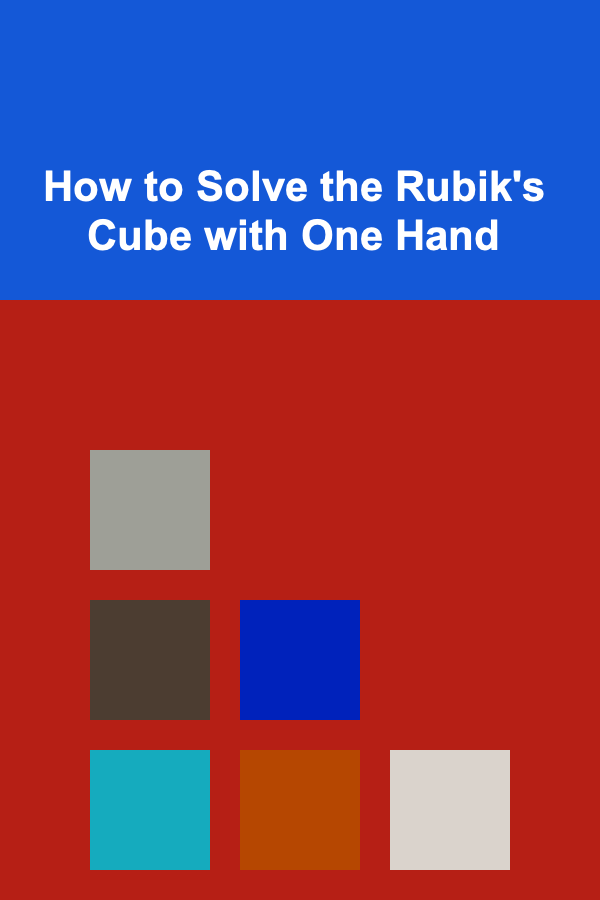
How to Solve the Rubik's Cube with One Hand
ebook include PDF & Audio bundle (Micro Guide)
$12.99$9.99
Limited Time Offer! Order within the next:

The Rubik's Cube is a 3D combination puzzle that has fascinated people around the world since it was invented by Ernő Rubik in 1974. It has become one of the most iconic puzzles ever created, with millions of people attempting to solve it each year. While most people solve the Rubik's Cube using two hands, solving it with one hand (OH) adds a level of difficulty that requires significant skill, dexterity, and practice.
This article aims to guide you through the process of solving the Rubik's Cube with one hand. We'll explore the necessary techniques, strategies, and tips that can help you master the one-handed solving method. Whether you're a beginner or an experienced cuber, understanding the intricacies of solving the cube one-handed will allow you to improve your skills and impress your friends.
Understanding the Basics of the Rubik's Cube
Before diving into one-handed solving, it is essential to understand the fundamentals of the Rubik's Cube. The standard 3x3 Rubik's Cube consists of six faces, each with nine smaller squares, giving a total of 54 stickers. The cube can be twisted and turned in different ways, leading to a multitude of possible combinations.
Each face of the Rubik's Cube is identified by a specific color: white, red, blue, orange, green, and yellow. The goal of the puzzle is to arrange the cube so that each face consists of a single solid color. While solving the cube, there are specific algorithms (sequences of moves) that can be used to manipulate the cube in a controlled manner.
1.1 Notation and Movements
In order to solve the Rubik's Cube efficiently, it is essential to understand the notation used for describing moves. The basic movements of the cube are as follows:
- U (Up): Rotate the upper face clockwise.
- U' (Up Prime): Rotate the upper face counterclockwise.
- D (Down): Rotate the bottom face clockwise.
- D' (Down Prime): Rotate the bottom face counterclockwise.
- L (Left): Rotate the left face clockwise.
- L' (Left Prime): Rotate the left face counterclockwise.
- R (Right): Rotate the right face clockwise.
- R' (Right Prime): Rotate the right face counterclockwise.
- F (Front): Rotate the front face clockwise.
- F' (Front Prime): Rotate the front face counterclockwise.
- B (Back): Rotate the back face clockwise.
- B' (Back Prime): Rotate the back face counterclockwise.
When solving with one hand, you will still use these movements, but the primary challenge is controlling the cube with just one hand. This requires adapting your grip and utilizing your fingers and thumb efficiently.
The Fundamentals of One-Handed Solving
One-handed solving requires more than just the basic understanding of the cube. It demands a unique approach to both physical technique and algorithm execution. Below are key concepts that you will need to consider as you learn how to solve the Rubik's Cube one-handed:
2.1 Grip
The most fundamental aspect of solving the Rubik's Cube one-handed is how you hold the cube. Unlike two-handed solving, where both hands can be used for different movements, one-handed solving requires you to maintain control of the cube with just one hand while performing all the necessary moves. Here's a breakdown of how to hold the cube:
- Thumb and Middle Finger: Hold the cube with your thumb on one of the side faces (usually the front face) and your middle finger on the opposite side (usually the back face). This will provide the balance you need to manipulate the cube.
- Index Finger: Use your index finger to press and rotate the upper and lower layers of the cube. Your index finger will also play a role in pushing and pulling the cube as needed.
- Ring Finger: Use the ring finger to stabilize the cube, especially when you need to turn the middle layers.
- Pinky Finger: The pinky is typically less involved in direct movement but can be used for stabilization and to shift the cube slightly for better positioning.
2.2 Fingers and Wrist Movements
When solving the Rubik's Cube one-handed, it's important to use your fingers and wrist efficiently. Since you're using just one hand, wrist movements become more critical, especially when you need to rotate layers quickly.
- Flicking with the Thumb: The thumb is typically used to flick the top layer of the cube. It can also be used for rotating the upper layers when combined with finger movements.
- Using the Index Finger: The index finger is crucial for pushing the bottom layers of the cube. It allows you to manipulate the cube's faces without needing your other hand.
- Wrist Rotation: Many moves, particularly for the middle and bottom layers, require wrist rotation to maintain speed and fluidity. The wrist should be relaxed and flexible to allow for quick, precise turns.
2.3 Efficiency and Speed
Speed in one-handed solving is a result of both muscle memory and efficient movement. One-handed solving may seem slow at first, but with practice, you can increase your speed by focusing on the following:
- Minimize Unnecessary Movements: Just as in two-handed solving, one-handed solving benefits from minimizing excess movements. Every move should be purposeful and help you solve the puzzle more efficiently.
- Use Shorter Algorithms: In two-handed solving, long algorithms may be easier to execute, but in one-handed solving, shorter algorithms are often faster. This is especially true when executing algorithms that require multiple rotations.
- Practice Finger Substitution: One of the most advanced techniques for improving speed is finger substitution, where you use different fingers for different moves to reduce the overall time spent on a specific rotation.
Step-by-Step Guide to Solving the Rubik's Cube One-Handed
Now that you understand the basics of one-handed solving, let's break down the process of solving the Rubik's Cube with just one hand. The method we will use is similar to the CFOP (Cross, F2L, OLL, and PLL) method, which is widely used by speedcubers for fast solving.
3.1 Step 1: Solving the White Cross
The first step in solving the Rubik's Cube is to create a cross on the white face. You will need to align the white edges with the corresponding center pieces on the adjacent faces. To do this one-handed, follow these steps:
- Hold the cube so that the white center piece is facing you.
- Use your thumb and index finger to rotate the top layer, aligning the white edge pieces with the center pieces on the adjacent faces.
- Ensure that each white edge piece is correctly aligned with both the white center piece and the center piece of the adjacent color.
3.2 Step 2: Solving the First Two Layers (F2L)
After completing the white cross, the next step is to solve the first two layers (F2L). This involves solving the corner and edge pairs in the first two layers, positioning them correctly in relation to the white face.
- Find a corner and edge pair that need to be inserted into the correct position.
- Use your index and thumb to manipulate the top layer, inserting the pair into the correct spot.
- Repeat this process for each corner and edge pair, using your fingers and wrist for smooth movement.
3.3 Step 3: Solving the Orienting Last Layer (OLL)
Once the first two layers are completed, the next step is to orient the pieces of the last layer (OLL). This step involves manipulating the top layer to have all of the top stickers facing upwards (in this case, yellow).
- Hold the cube so that the yellow face is facing you.
- Use one-handed algorithms to rotate the top layer pieces until the yellow stickers are correctly oriented.
3.4 Step 4: Permuting the Last Layer (PLL)
The final step is to permute the last layer, which involves moving the pieces into their correct positions without disturbing the orientation.
- Identify which PLL algorithm you need based on the arrangement of the pieces on the last layer.
- Perform the PLL algorithm using your one-handed grip and wrist movements.
Tips for Improving Your One-Handed Solving
- Start Slowly: Begin by solving the cube one-handed at a slow pace. Focus on accuracy and getting comfortable with the movements.
- Use a Lubed Cube: A smooth, well-lubed cube makes a significant difference when solving one-handed. The easier it is to turn the cube, the less effort you'll need to exert.
- Practice Regularly: Like any skill, solving the Rubik's Cube one-handed requires consistent practice. Set aside time each day to practice and work on improving your speed.
- Analyze Your Performance: After solving the cube, analyze your movements and identify areas where you can improve. Are there any inefficient moves? Can you use different fingers to perform the same moves more quickly?
Conclusion
Solving the Rubik's Cube with one hand is a challenging and impressive skill to master. It requires patience, practice, and a deep understanding of both the mechanics of the cube and the physical techniques needed to manipulate it with just one hand. Whether you're aiming to compete in one-handed speedcubing competitions or simply want to impress your friends, following the steps and tips outlined in this article will help you improve your one-handed solving abilities.
With time and dedication, you'll find that solving the Rubik's Cube one-handed becomes a fluid, efficient, and enjoyable challenge. Keep practicing, and soon you'll be solving the cube with one hand as smoothly as with two.
Reading More From Our Other Websites
- [Personal Care Tips 101] How to Remove Nail Polish Without the Fumes or Harsh Chemicals
- [Rock Climbing Tip 101] Innovative Climbing Gadgets Revolutionizing the Sport
- [Biking 101] The Ultimate Guide to Bike Grips: Materials, Types, and Maintenance
- [Organization Tip 101] How to Design an Entryway that Reflects Your Personal Style
- [Organization Tip 101] How to Use Baskets and Boxes for Hidden Storage
- [Home Party Planning 101] How to Use Party Planning Apps to Organize Your Event Like a Pro
- [Paragliding Tip 101] Color, Motion, and Sound: Mastering the Key Elements of Paragliding Video Editing
- [Organization Tip 101] How to Manage Vintage Item Donations and Purchases
- [Home Storage Solution 101] How to Organize Kitchen Cabinets Like a Pro: Practical Organizers and Smart Layouts
- [Paragliding Tip 101] The Ultimate Maintenance Checklist for Harnesses, Lines, and Rigs

How to Incorporate Eco-Friendly Elements into Your Home Renovation
Read More
How to Make Money Online as an Electrician: 10 Actionable Ideas
Read More
Navigating the Complexities of Cloud Architectures: Strategies for Google Cloud Platform
Read More
The Financial Advisor's Guide: Strategies for Building Lasting Client Relationships
Read More
10 Tips for Displaying Art Prints in a Gallery Wall
Read More
10 Tips for Creating a Separation To-Do List for Pets
Read MoreOther Products

How to Incorporate Eco-Friendly Elements into Your Home Renovation
Read More
How to Make Money Online as an Electrician: 10 Actionable Ideas
Read More
Navigating the Complexities of Cloud Architectures: Strategies for Google Cloud Platform
Read More
The Financial Advisor's Guide: Strategies for Building Lasting Client Relationships
Read More
10 Tips for Displaying Art Prints in a Gallery Wall
Read More